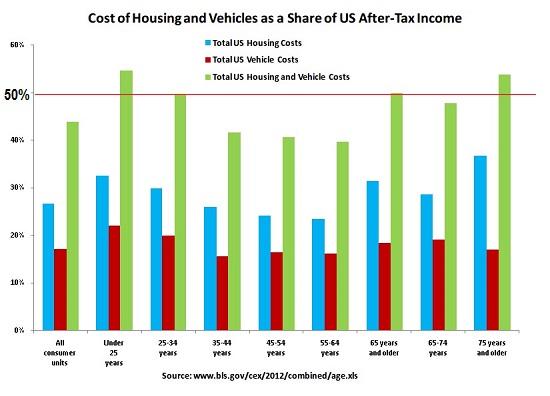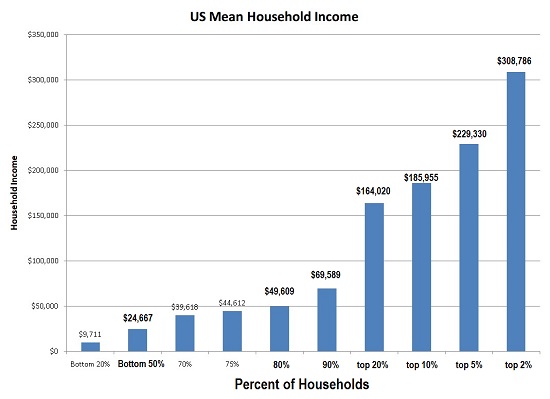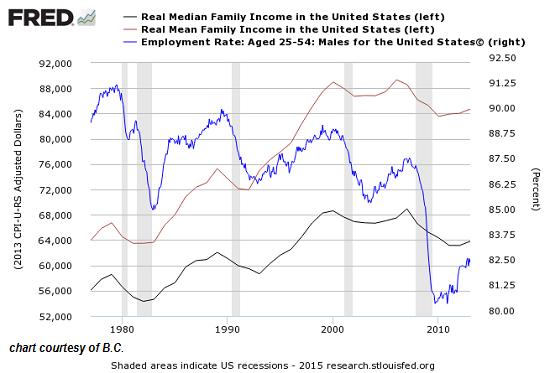Guest Post by Charles Hugh Smith
How do you support a consumer economy with stagnant incomes for the bottom 90%, rising basic expenses and crashing employment for males ages 25-54? Answer: you don’t.
Frequent contributor B.C. passed along a sobering set of charts that provide context for How The Average U.S. Consumer Spends Their Paycheck. The basic story is well-known to the bottom 90%: most of the household income goes to taxes, housing, food and transportation, with healthcare and insurance, pensions and retirement contributions rounding out the big-ticket items. (Higher education is, as we all know, paid with student loans by all but the top-tier of families.)
Here’s the question this raises: is the sliver that’s left enough to support a $17 trillion consumer economy? The answer is obvious: no.
Stagnant household income has a number of systemic causes, including the generational decline of full-time employment (A Rising Share of Young Adults Live in Their Parents’ Home) and the concentration of wage gains in the top 10%. These dynamics are not easily addressed, for the simple yet profound reason that the amount of human labor that generates a meaningful profit in a stagnant, over-indebted, financialized economy is declining.
The only way most enterprises can sustainably earn a profit is to offload costly human labor (with its immense burdens of healthcare, pensions, workers compensation, disability insurance, etc., and the heavy regulatory burdens of workplace rules) and replace it with networked software and smart machines.
The types of human labor that generate hefty profits are increasingly scarce, and as a result entry-level pay and employment are both capped by the high costs of human labor (even at minimum wage) and the relatively meager profits generated by conventional labor.
Most of the big profits are generated not by labor but by financialization, stock buybacks and other financial gaming of debt and leverage.
The few areas of human labor that generate hefty profits are either in the protected fiefdoms of state-enforced cartels, or in financial services (i.e. those playing the financial games with debt and leverage) or those creating the software and machinery that replaces costly human labor.
Here are B.C.’s comments on the data:
Nearly half of disposable income is spent on housing and food.
More than 50% of disposable household income is spent on housing and transportation (overwhelmingly autos).
25% of disposable income is spent on autos and health care.
Two-thirds of gross income is spent on taxes, housing, transportation, and health care.
Millennials, most especially males, coming of age since the mid- to late 2000s do not earn enough to afford the major components of household spending, i.e., taxes, housing, autos, and health care (insurance).
The self-reinforcing feedback effect of lack of gainful employment and after-tax earned income causing insufficient purchasing power for housing, auto transport, and healthcare insurance that then results in lack of growth of demand for same will persist indefinitely hereafter, i.e., permanently, including reducing the rate of coupling, marriage, fertility, household formation, etc.
Here is a chart of housing and vehicle costs, broken down by age group. Note that only the peak-earnings middle groups spend less than 50% on housing and transportation.

The concentration of earnings in the top 10% and 5% is clear: the bottom 50% of households earn a fraction of the top 10%, and the bottom 90% get by with less than a third of the income of the top 5%:

The recent decline in male employment in the peak earning years (ages 25-54) is striking: the employment rate for males ages 25-54 has been stairstepping down for 30 years, but it literally fell off a cliff in 2009:

How do you support a consumer economy with stagnant incomes for the bottom 90%, rising basic expenses and crashing employment for males ages 25-54? Answer: you don’t. The media shills, government lackeys and PR-pimps can spin the GDP and other gamed statistics as much as they want, but no amount of statistical gaming will change the stagnation that results from generational declines in employment, flat wages and rising basic household expenses.



Greetings,
Do not expect this trend to auto-correct itself. In the future, there will be owners and then there will be everyone else. Position yourself now or plan to live in a cardboard box on the edge of town.